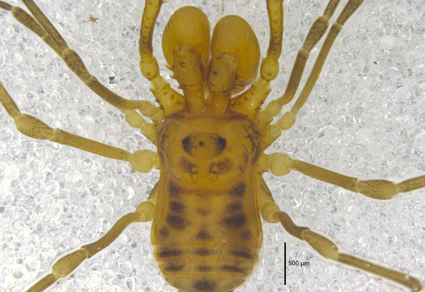Abstract
Tegestria altmannae sp. nov. is described and illustrated based on male and female specimens collected in Malaysia. It is characterized by the unarmed dorsal scutum, and basal segment of chelicerae dorsally with three seta-tipped tubercles. The type species of the monotypic genus Gintingius Roewer, 1938, G. robustus Roewer, 1938, is treated as a new synonym of Tegestria coniata Roewer, 1938 and the genus Gintingius as a new synonym of Tegestria Roewer, 1936, accordingly.
References
- Acosta, L.E., Pérez-González, A. & Tourinho, A.L. (2007) Methods for taxonomic study. In: Pinto-da-Rocha, R., Machado, G. & Giribet, G. (Eds.), Harvestmen: The biology of Opiliones. Harvard University Press, Cambridge and London, pp. 494–510.
- Kury, A.B. (2007) Epedanidae Sørensen, 1886. In: Pinto-da-Rocha, R., Machado, G. & Giribet, G. (Eds.), Harvestmen: The biology of Opiliones. Harvard University Press, Cambridge and London, pp.188–191.
- Kury, A.B., Mendes, A.C., Cardoso, L., Kury, M.S., Granado, A.de A. Giribet, G., Cruz-López J.A., Longhorn, S.J., Medrano, M., Kury, I.S. & Souza-Kury, M.A. (2022) World Catalogue of Opiliones. WCO-Lite Version 2.5.1. Available from: https://wcolite.com/ (accessed November 2022)
- Kury, A.B., Pérez-González, A. & Proud, D. (2019) A new Indo-Malayan family of Grassatores (Arachnida, Opiliones, Laniatores). Invertebrate Systematics, 33(6), 892–906. https://doi.org/10.1071/IS19035
- Kury, A.B. & Villarreal, M.O. (2015) The prickly blade mapped: establishing homologies and a chaetotaxy for macrosetae of penis ventral plate in Gonyleptoidea (Arachnida, Opiliones, Laniatores). Zoological Journal of the Linnean Society, 174, 1–46. https://doi.org/10.1111/zoj.12225
- Lian, W.G., Zhang, C. & Zhang, F. (2011) Review of the genus Plistobunus Pocock, 1903, with description of a new species from Hainan Island, China (Opiliones, Laniatores, Epedanidae). ZooKeys, 112, 39–52. https://doi.org/10.3897/zookeys.112.1110
- Macías-Ordóñez, R., Machado, G., Pérez-González, A. & Shultz, J. (2010) Genitalic Evolution in Opiliones. In: Leonard, J. & Córdoba-Aguilar, A. (Eds.), The Evolution of Primary Sexual Characters in Animals. Oxford University Press, New York, New York, pp. 285–306.
- Martens, J. (1986) Die Grossgliederung der Opiliones und die Evolution der Ordnung (Arachnida). In: Barrientos, J.A. (Ed.), Actas del X Congreso Internacional de Aracnología. Editorial Juvenil, Barcelona, pp. 289–310.
- Roewer, C.F. (1912) Die Familien der Assamiiden und Phalangodiden der Opiliones-Laniatores. (= Assamiden, Dampetriden, Phalangodiden, Epedaniden, Biantiden, Zalmoxiden, Samoiden, Palpipediden anderer Autoren). Archiv für Naturgeschichte, Berlin, Abt. A, Original-Arbeiten, 78 (3), 1–242.
- Roewer, C.F. (1923) Die Weberknechte der Erde. Systematische Bearbeitung der bisher bekannten Opiliones. Gustav Fischer, Jena, 1116 pp.
- Roewer, C.F. (1936) Opiliones aus Malaya. Bulletin of the Raffles Museum, 12, 72–76.
- Roewer, C.F. (1938) Über Acrobuninae, Epedaninae und Sarasinicinae. Weitere Weberknechte IX. (9. Erganzung der "Weberknechte der Erde" 1923). Veröffentlichungen aus dem Deutschen Kolonial- und Übersee-Museum in Bremen, 2 (2), 81–169.
- Schwendinger, P.J. & Martens, J. (2002) A taxonomic revision of the family Oncopodidae III: Further new species of Gnomulus Thorell (Opiliones, Laniatores). Revue suisse de zoologie, 109, 47–113. https://doi.org/10.5962/bhl.part.79580
- Sørensen, W.E. (1886) Opiliones. In: Koch, L. & Keyserling, E. von (Eds.), Die Arachniden Australiens nach der Natur beschrieben und abgebildet. Vol. [Theil] 2 of two volumes & atlas, 1871–1889. Fascicle [Lieferung] 33. Bauer & Raspe, Nürnberg, pp. 53–86.
- Suzuki, S. (1969) On a collection of opilionids from Southeast Asia. Journal of Science of the Hiroshima University, 22 (2), 11–77.
- Suzuki, S. (1973) Opiliones from the South-west Islands, Japan. Journal of Science of the Hiroshima University, 24, 205–279.
- Suzuki, S. (1977) Report on a collection of opilionids from the Philippines. Journal of Science of the Hiroshima University, 27 (1), 1–120.
- Suzuki, S. (1982) A small collection of harvestmen from Malaysia (Opiliones, Arachnida). Acta Arachnologica, 31 (1), 27–34. https://doi.org/10.2476/asjaa.31.27
- Thorell, T.T.T. (1890) Aracnidi di Pinang raccolti nel 1889 dai Sig.ri L. Loria e L. Fea. Annali del Museo Civico di Storia Naturale di Genova, 10 (= 30), 269–383. [“1890–1891”]
- Zhang, C. & Martens, J. (2020) A taxonomic study on Epedanidae from Thailand including functional aspects of male genital morphology (Opiliones, Laniatores). ZooKeys, 915, 25–58. https://doi.org/10.3897/zookeys.915.47626


